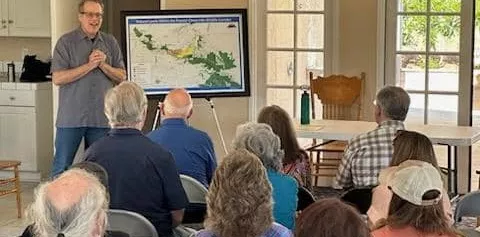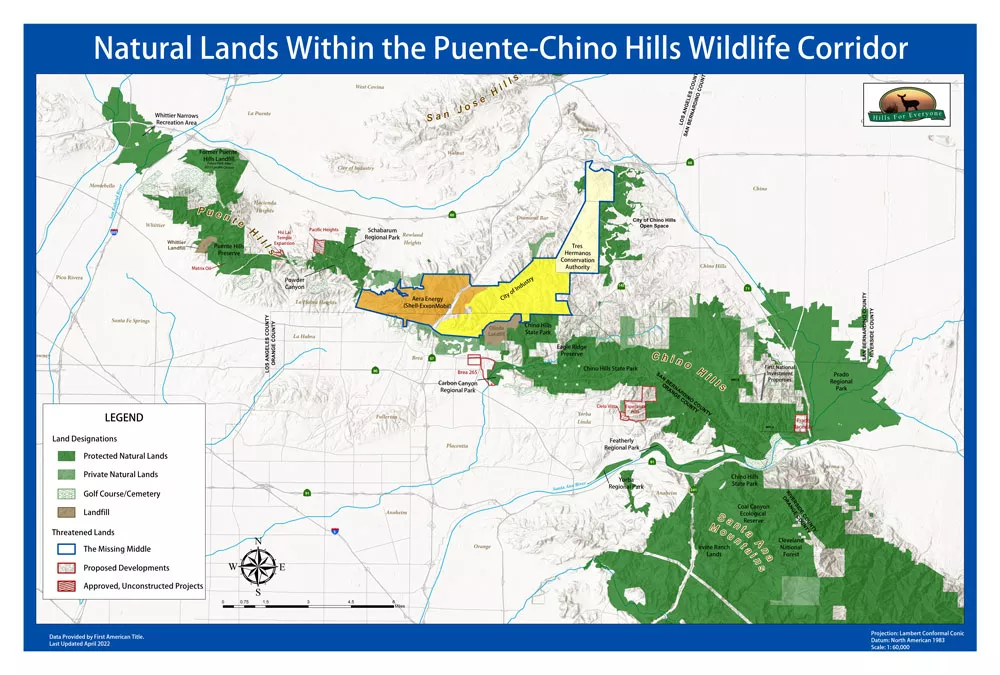by Eric Johnson,
Chair of the Sierra Club Puente-Chino Hills Task Force
An oasis of beauty in a sea of sprawl
A remarkable remnant of southern California hillsides remains in essentially its natural state at the juncture of Los Angeles, Orange, Riverside and San Bernardino Counties. Known as the Puente-Chino Hills Wildlife Corridor, large swaths of land have been protected at both ends of this 31-mile-long hillside system. The hills themselves represent the trailing off of the Santa Ana Mountains, interrupted only by tenacity and force of the Santa Ana and San Gabriel Rivers.

For four decades residents and their elected officials have worked to protect this backbone and backdrop of open space in one of the most highly engineered regions on the planet. Under Whittier’s leadership, 4,000 acres have been saved on the western end of the hills while another 14,000 acres have been saved on the eastern end in Chino Hills State Park. The Coal Canyon exit off the Riverside Freeway, previously used by vehicles, is protected land and provides a linkage for wildlife to move back and forth between the hills and the Santa Ana Mountains.

The Whittier Elsinore Fault also runs through these hills, creating a rupture that led to conditions amenable to the formation of oil on the south side of the fault. Oil companies have developed oil fields for the last 100 years, but as the wells run dry, plans for the next use of the land emerge. Many oil companies have chosen to sell their land for preservation. One very big exception remains.
In the early 2000s, Aera Energy, (which you may know as the company that wanted to develop Banning Ranch), submitted a development proposal to Los Angeles and Orange Counties to build 3,600 units in the undeveloped hills along the 57 Freeway between Diamond Bar and Brea. This wonderful oak and walnut woodland is known as the "Missing Middle" of the Puente-Chino Hills Wildlife Corridor because thousands of acres of land have been saved on either side.
Aera Energy owns 2,700 acres of unincorporated land in southeastern Los Angeles County and about 300 acres in unincorporated Orange County in Brea’s sphere of Influence. Aera's proposed project would not only sever the Wildlife Corridor and destroy important walnut and oak woodlands, but it would also add 40,000 vehicle trips per day to already congested roads and freeways.
Los Angeles County says No
This spring the Los Angeles County Board of Supervisors rezoned the LA County land to either one unit per 40 acres or one unit per 10 acres. They did this to recognize the importance of these lands and to match up with the restrictions in the County’s Significant Ecological Area Ordinance. These efforts were led by Supervisors Janice Hahn and Hilda Solis.
But Orange County says Maybe
But the Missing Middle that is part of Orange County is still at risk. Orange County is trying to cram 1,857 units into the 300 acres of this hilly, geologically unstable land as part of their Housing Plan submittal to the State. At this point, the State is calling that plan unrealistic, and we hope that Orange County comes to its senses and instead takes a hint from Los Angeles County in realizing that the best use for this land is as protected open space. Tell your supervisor, especially Supervisor Chaffee, that this land should be protected.
Puente-Chino Hills Task Force
The Puente-Chino Hills Task Force works to protect the Wildlife Corridor from this threat as well as others within the Wildlife Corridor.
The Task Force also has monthly hikes at various spots along the wildlife corridor from October through May. These hikes allow people to learn about the importance of the Corridor and to enjoy its natural beauty.
For more information on these issues or to come to one of our monthly hikes, go to www.SaveTheWildlifeCorridor.org.